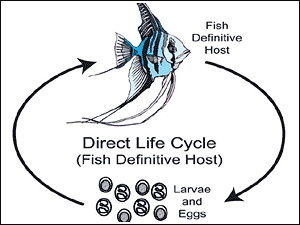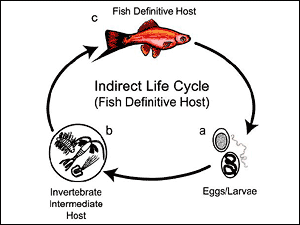

 |
||||||||||||
 |
||||||||||||
| Nematode (Roundworm) Infections in Fish | ||||||
| Page 3 of 11 | Pages: 1 . 2 . 3 . 4 . 5 . 6 . 7 . 8 . 9 . 10 . 11 | |||||
Life Cycles Nematode life cycles differ depending upon the species of nematode. Typical life cycles are summarized in Figures 6-8. Organisms that contain the reproductive adult stages of nematodes are known as final or definitive hosts. Organisms that are required for the completion of a nematode life cycle but do not contain the final reproductive adult stage are known as intermediate hosts. There are two major categories of nematode life cycles DIRECT and INDIRECT. If the nematode has a DIRECT life cycle ( Figure 6 ), then it does not need an intermediate host and infection can spread directly from one fish to another by ingestion of eggs or larvae.  Figure 6: Direct life cycle. Nematode can infect fish directly without the need for an intermediate host.
Figure 6: Direct life cycle. Nematode can infect fish directly without the need for an intermediate host.
If the nematode has an INDIRECT life cycle (Figures 7 and 8), the eggs or larvae are excreted into the water and, during development, immature stages pass through at least two different types of organisms, one of which may be a fish. Depending upon the role of the fish, indirect life cycles can also be subcategorized by whether the fish is (i) the definitive (final) host or (ii) an intermediate host. i) Indirect life cycle where the fish is the final (definitive) host ( Figure 7 ) If the fish is the definitive or final host, then the nematode will enter another organism usually an aquatic invertebrate such as a copepod, side swimmer (such as Gammarus spp.), tubifex worm, or insect larva in which it will further develop prior to being eaten by a fish. After being eaten by the correct species of fish, some species of nematode reach sexual maturity and reproduce in these fish. In such a case, the fish are considered the "definitive" or "final" host for these nematode species. ii) Indirect life cycle where the fish is an intermediate host ( Figure 8 ) Nematodes that have this type of life cycle use fish species as intermediate hosts only. The final host (which contains the reproductive adult stage of the nematode) may be a piscivorous (fish-eating) fish, bird or mammal.  Figure 7: Indirect life cycle where the fish is the final (definitive) host. The nematode eggs/larvae (a) enter an aquatic invertebrate intermediate host (b), such as a copepod, tubifex worm, or insect larva, prior to being eaten by or entering the final host fish (c).
Figure 7: Indirect life cycle where the fish is the final (definitive) host. The nematode eggs/larvae (a) enter an aquatic invertebrate intermediate host (b), such as a copepod, tubifex worm, or insect larva, prior to being eaten by or entering the final host fish (c).
more ... |
 |
|||||
| About Us :: Message Board :: Chat | |||||
| Library :: Photo Gallery :: Links & Resources :: Breeders & Sponsors :: Merchandise | |||||
| Website designed by: EthanCote.com | © 2001-2004, SimplyDiscus.com. All Rights Reserved. | ||||